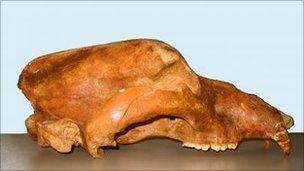Early human 'squatters' drove cave bears to extinction
- Published

Cave bears and humans went head-to-head in Ice Age Europe
Ice Age bears may have been wiped out when humans began to take over their caves, scientists claim.
A new DNA study shows that cave bear populations started to decline around 50,000 years ago, coincident with the time that human numbers increased.
Caves were essential for these Ice Age bears to hibernate during the winter months.
The arrival of human "squatters" who occupied caves made the bears homeless, leading to their untimely extinction.
The findings are published in the journal Molecular Biology and Evolution by a team led by Dr Mathias Stiller of the Max Planck Institute, Germany.
The cave bear is a close relative of the modern brown bear. They both evolved from a common ancestor about 1.2 million years ago.
These were fearsome creatures; males could weigh as much as 500kg (about 1000lb).
In the new study, scientists studied mitochondrial DNA extracted from well-dated fossil bear skeletons to work out how population size changed over time.
During sexual reproduction, mitochondrial DNA is inherited exclusively from the mother. Its variability is a measure of the number of females in a population at a given time.
The team found that cave bears went into decline 50,000 years ago, before finally going extinct 24,000 years ago. In contrast, the population of brown bears remained stable through the same period.

Some European caves are filled with the skeletons of Ice Age bears
Although researchers could find no link between the crash in cave bear populations and other factors, the event did "coincide with the start of human expansion," commented co-author Dr Aurora Grandal-D'Anglade of the University of Coruna, Spain.
A possible reason for this is that, as human started to occupy cave sites, bears were made homeless.
Brown bears did not suffer the same fate as cave bears and have survived until today.
"Brown bears rely less on [caves] for hibernation," Dr Grandal-D'Anglade explained. "In fact, their fossil remains are not very numerous in cave deposits".
So the downfall of the cave bear may have been triggered by competition with human for caves.
Climate chaos?
Dr Danielle Schreve of Royal Holloway, University of London, an expert on Ice Age animals who was not involved in the current study, cast doubt on this new interpretation.
"There were lots of other Ice Age mammals - for example, spotted hyaenas and lions - that used caves. However, these didn't decline in the same way, which would have been expected if human competition was the key factor," she told BBC News.
Vegetation change caused by the Ice Age climate fluctuations is an alternative explanation for cave bear demise.
Dr Schreve explained, "Cave bears were much more dependent on a vegetarian diet than the more adaptable brown bear".
"Competition with humans may have been the final nail in the coffin, but the cave bear was already doomed," due to climate change, she said.